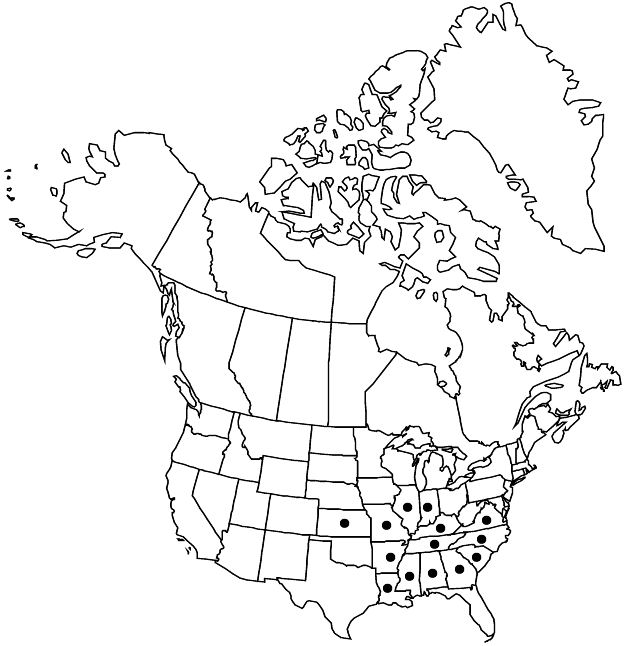Crataegus collina
Fl. S.E. U.S. ed. 2 repr. 2, 684. 1892.
Shrubs, 60–80 dm. Stems: twigs: new growth pubescent, 1–2-years old grayish brown, older gray; thorns on twigs few to numerous, ± straight, 1-year old dark gray, usually ± slender, 2–4 cm. Leaves: petiole 1 cm, length 10–20% blade, unwinged part often short or absent, pubescent, eglandular; blade rhombic-obovate or broadly elliptic, sometimes ± narrowly obovate, ± obtrullate, or broadly rhombic-elliptic, 3–5 (–7.5) cm, 1.4–2.5 times as long as wide, base tapering into petioles, lobes 0, or 1 or 2 (or 3) per side, lobe apex acute to subacute, rarely obtuse, margins serrate in distal 3/4, veins 5–7 per side, apex subacute to obtuse, abaxial surface scabrous-pubescent, especially on veins, adaxial scabrous-pubescent young, glabrescent. Inflorescences 5–10-flowered; branches appressed-pubescent; bracteoles membranous, margins sessile or short-stipitate-glandular; flowering usually early, often before full leaf expansion. Flowers (10–) 13–18 (–20) mm diam.; hypanthium glabrous or ± sparsely pubescent; sepal margins usually glandular-serrate, abaxially glabrous; stamens (5–) 20, anthers white, cream, or rose; styles (3–) 5. Pomes orange or ruddy to deep red, orbicular, 8–14 mm diam., punctate, usually glabrous; sepals patent-reflexed; pyrenes (3–) 5.2n = 34, 51, 68.
Distribution

Ala., Ark., Ga., Ill., Ind., Kans., Ky., La., Miss., Mo., N.C., S.C., Tenn., Va.
Discussion
Varieties 5 (5 in the flora).
Crataegus collina is found from Oklahoma and Kansas to the Atlantic. It is absent from middle and higher elevations in the Appalachians, where it is replaced by C. punctata.
Crataegus collina is similar to its almost allopatric counterpart C. punctata, differing in its less tabulate growth habit, leaves on extension shoots not deeply incised, fewer-flowered inflorescences, fewer (5–7 vs. 7–10) and less impressed veins, often wider leaf shape (especially in var. hirtiflora), somewhat darker twig color, sepal margins more or less glandular-serrate, and sometimes different stamen number. Crataegus collina is one of the first hawthorns to flower in its area of distribution, unlike C. punctata, which is late mid season. Crataegus ×disperma (see Interserial Hybrids) is somewhat similar to C. collina; it is allopatric and usually has more lateral leaf veins and fewer pyrenes. Crataegus collina is apparently intolerant of drought and is often leafless by late August in dry summers.
Crataegus collina is variable and has been divided into varieties. The varieties have been worked out in Missouri but not systematically recorded elsewhere; the varietal distributions provided here may be incomplete. Three putative hybrids between C. collina or C. punctata (C. ×collicola, C. ×disperma, and C. ×incaedua) are included in the following key.
Selected References
None.
Lower Taxa
Key
| 1 | Styles and pyrenes 2 or 3; stamens 10–15; leaves: adaxial surfaces sparsely hairy or subglabrous young | > 2 |
| 1 | Styles and pyrenes (3–)5; stamens (5–)15–20; leaves: adaxial surfaces short-pubescent, puberulent, or pubescent young (except var. sordida and C. ×collicola) | > 3 |
| 2 | Inflorescence branches glabrous; anthers pink or red-purple. | Crataegus ×disperma |
| 2 | Inflorescence branches puberulent; anthers cream. | Crataegus ×incaedua |
| 3 | Leaf blades 2/3 to nearly full grown at anthesis, length/width = 1.3, lobes, if present, usually obtuse | > 4 |
| 3 | Leaf blades usually 1/3–1/2 full grown at anthesis, length/width = 1.4–2.25+, lobes, if present, usually acute | > 5 |
| 4 | Stamens 15–20; leaf blades 3–5 cm, lobes 0 or obscure. | Crataegus collina var. hirtiflora |
| 4 | Stamens 5–15(–20); leaf blades 5–7.5 cm, lobes 1 or 2 per side. | Crataegus collina var. lettermanii |
| 5 | Anthers white or cream | > 6 |
| 5 | Anthers rose | > 7 |
| 6 | Leaf blades at anthesis: length/width = 1.4–1.7; flowers 14–18 mm diam. | Crataegus collina var. collina |
| 6 | Leaf blades at anthesis: length/width = 1.75–2.25; flowers 10–12 mm diam | Crataegus collina var. succincta |
| 7 | Leaf blades at anthesis: length/width = 1.75–2.25. | Crataegus collina var. succincta |
| 7 | Leaf blades at anthesis: length/width = 1.4–1.5 | > 8 |
| 8 | Leaf margins serrate distally, teeth 1.5 mm. | Crataegus collina var. sordida |
| 8 | Leaf margins serrulate, teeth 0.5–0.7 mm. | Crataegus ×collicola |
"thin" is not a number."short" is not a number."pubescent" is not a number."adnate" is not a number."dm" is not declared as a valid unit of measurement for this property.